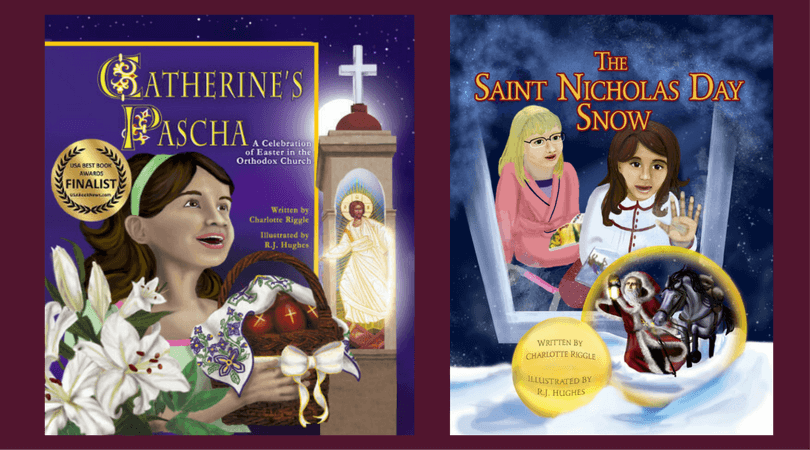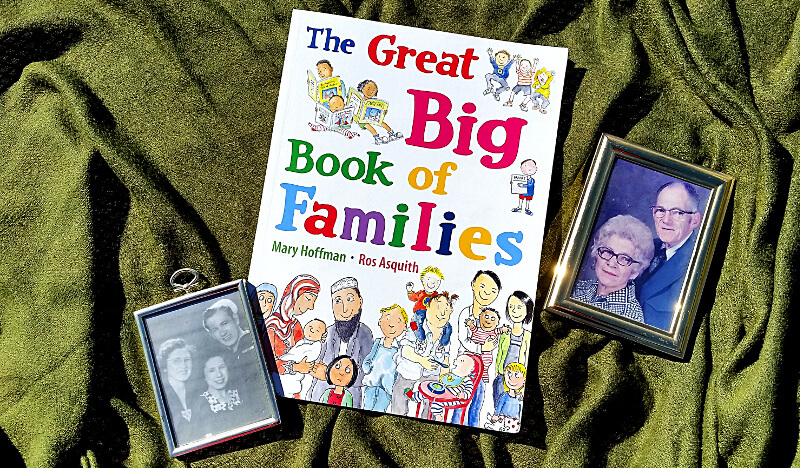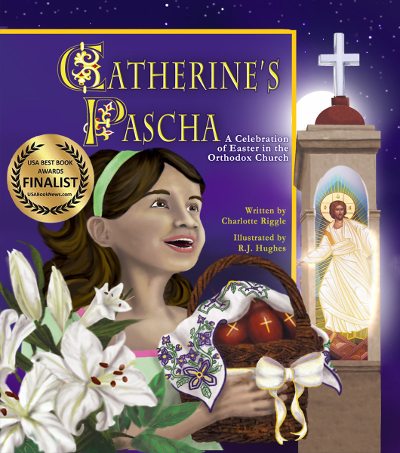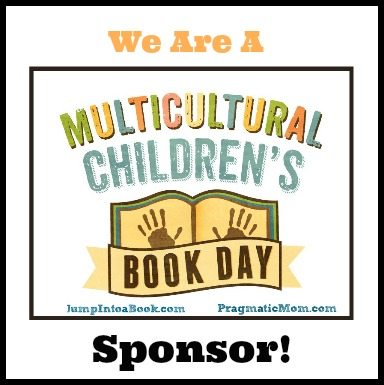There are so many reasons to share picture books with your children. Picture books build your child’s vocabulary and improve your child’s reasoning skills. They provide an engaging activity for quiet times and for settling down to sleep. And they allow you to teach your child about sad and scary things (like poverty or racism or the death of a beloved pet) in a setting that is safe and supportive.
Picture books let you introduce your child to all sorts of people. Your child might not know anyone in real life who uses a wheelchair, for example, or who is blind. But if your child meets Elizabeth in The Saint Nicholas Day Snow, or Zulay in My Three Best Friends and Me, Zulay, they’ll know that there’s nothing scary about wheelchairs or white canes. And they won’t point, stare, and cause a scene by asking loud, embarrassing questions in public, because you’ll have already shared your experiences and wisdom with them.
All sorts of families
The Great Big Book of Families by Mary Hoffman and Ros Asquith is an incredible book that lets you introduce your child to all sorts of families. It’s not a story. Rather, with a plain and matter-of-fact voice, it talks about all the many ways that families can be different.
It starts with families, and who’s in a family. It goes on to talk about homes, school, jobs, holidays (the authors are British, so that means vacations), food, clothes, pets, celebrations, hobbies, transport, feelings. And it includes an activity for making a family tree.
For each subject, the text covers a wide range of possibilities. In The Great Big Book of Families, your children will see people like themselves and people they know on every page. And they will see people who are different.
For school, for example, it says, “Most children go to school. But some are taught at home. And some just won’t go to school. Others are too young to go to school.” One of my children developed school phobia (yes, that’s a real thing), and just wouldn’t go to school. I’ve never seen school refusal mentioned in a book anywhere before, ever – much less a children’s book. It would have been amazing to share that page with my child when we were working to reintroduce school. And, of course, it’s good to see going to school and learning at home presented side by side.
Uncomfortable differences
The Great Big Book of Families includes differences that might make some parents uncomfortable. When it talks about jobs, for example, it says, “In some families everyone has jobs. In others only one person goes out to work. Some parents work from home. And some can’t get a job at all.” For homes, it says, “People live in all sorts of homes. Some small families live in big houses. And some big families live in tiny flats. And some people can’t find anywhere to live.”
Homelessness and unemployment are heavy subjects. They may seem too heavy to introduce to young children. But Hoffman and Asquith present them in a totally matter-of-fact way, without either judgment or pity. That’s important, because many young children experience homelessness, and they may have parents who are, or have been, unemployed. Having their situation acknowledged in a book can help a child feel less isolated and alone.
The book is also matter-of-fact in its presentation of different family constellations. It says, “Lots of children live with their mummy and daddy or just their mummy. Some live with their grandma and grandpa. Some children have two mummies or two daddies. And some are adopted or fostered.” Hoffman and Asquith don’t present the less traditional families as issues or problems. They’re just families. Families that include children that you know and love.
What they missed
The only significant miss in The Great Big Book of Families is religion. The book does show people in clothing associated with various faiths, and on the page about celebrations, there is a menorah. But I’d have loved a spread that said that some people worship at a church, some at a synagogue, some at a mosque, some at a temple, some at home, and some don’t worship anywhere. That would have fit beautifully in the book. I’m sad it’s not there.
The illustrations
The illustrations in The Great Big Book of Families are delightful. And they introduce more diversity than is in the text. You’ll see people who are young, and people who are old. You’ll see working moms and stay-at-home dads. There are children who use wheelchairs, and children who use walkers. You’ll see different races and ethnicities, and you’ll see multiracial families.
There are little jokes in the illustrations that are there to delight the parents. In the spread about food, for example, the butcher shop is Aiken Drum. Next door is Tom the Piper’s Son Take-Away, then Miss Muffet’s sweet shop, Jack Horner Fruit and Veg, and Simple Simon’s bakery. Your child might not notice the names of the shops – but you will.
And there’s an orange tabby cat that shows up on every page. Your children will love finding the cat.
Read More
The best picture books with disabled characters: These books have interesting stories and engaging characters who just happen to have disabilities. They’re a great way to introduce your child to many different sorts of people.
Father and SonA Review: In this poetic book, St. Joseph talks about what it means to be the foster father of God: “How can I put a roof over your head, knowing it was you who glass-roofed the world and thatched the sky with clouds, and stitched the snow with threads of melting silver?”
Disabilities and special needs in the Church: Meeting people with disabilities in books is important. Welcoming people with disabilities in your parish is even more important.
Buy the Books!

These delightful books will diversify your bookshelves with disability representation. Elizabeth, one of the main characters, is an ambulatory wheelchair user.
Catherine’s Pascha
FINALIST IN THE 2015 USA BEST BOOK AWARDS
Catherine doesn’t like vegetables. She doesn’t like naps. She doesn’t like it when her mom combs her hair. She loves hot dogs, chocolate cake, and her best friend, Elizabeth. Most of all, she loves Pascha! Pascha, the Orthodox Christian Easter, is celebrated in the middle of the night, with processions and candles and bells and singing. And Catherine insists that she’s not a bit sleepy.
Celebrate the joy of Pascha through the magic of a book: Catherine’s Pascha. Available on Amazon, Bookshop.org, and my webstore.
The Saint Nicholas Day Snow
Shoes or stockings? Horse or sleigh? Does St. Nicholas visit on December 6 or on Christmas Eve? Will a little girl’s prayer be answered? When Elizabeth has to stay at Catherine’s house, she’s worried about her grandmother, and worried that St. Nicholas won’t find her. The grownups, though, are worried about snow.
Celebrate the wonder of St. Nicholas Day through the magic of a book: The Saint Nicholas Day Snow. Available on Amazon, Bookshop.org, or my webstore.




Why are we supporting the idea that it’s okay for children to live in broken households; with only a mother or “two mother’s or father’s”
I’m from a broken home and to lie to the kids only makes it worse.
Thanks for your comments, Theophan. One of the reasons I like the book so much is that it acknowledges that many children live in less than ideal circumstances. Some live in broken households. Some are homeless. These children may feel comforted when they see families like their own in a book. If it brings up painful memories for you, you may prefer other books.
Sounds wonderful. I may have to get it for my grandson. Thank you for the comprehensive review.
I hope your grandson enjoys it!
I appreciate books that depict a variety of experiences; this sounds like a great addition to my library. I’ve added it to my order. As an adoptive family coach, I deal with families that can include a great deal of diversity. It is valuable for kids to see this reflected in the books they read.